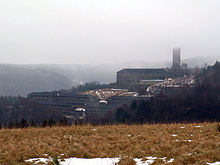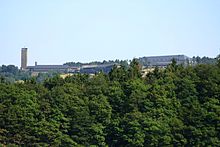- Ordensburg Vogelsang
-
Ordensburg Vogelsang is a former national socialist estate placed at the former military training area in the national park Eifel in North Rhine-Westphalia. The landmarked and completely preserved estate was used by the National Socialists between 1936 and 1939 as an educational centre for future leaders. Since 1 January 2006 the area is open to visitors. It is one of the largest architectural relics of National Socialism. The gross area of the landmarked buildings is 50,000 m².
Contents
History
Planning and construction since 1933
In a 1933 speech in Bernau near Berlin, Adolf Hitler demanded that new schools be built for the children of the leaders of his national socialist German labour party (NSDAP). The task was given to Robert Ley, the "Reichsorganisationsleiter" (literally: Reich Organisational Leader) of the NSDAP, who undertook the construction and operation of four educational camps (NS-Ordensburgen):
- Ordensburg Krössinsee, in Pomerania
- Ordensburg Sonthofen, Allgäu
- Ordensburg Vogelsang, Eifel
A fourth one was planned at (the historic) Ordensburg Marienburg, in West Prussia
The construction of Ordensburg Vogelsang, most of which lies within the district of the town of Schleiden, was financed by expropriating trade unions and employers' associations. The contract for planning the Krössinsee and Vogelsang projects went to the Cologne architect Clemens Klotz.
The three buildings at Eifel have been known as "NS-Ordensburg" since 1935. The first phase of the project was the construction of the Castle of Vogelsang, which with up to 1,500 workers took only two years. Several much bigger buildings were also planned, such as a huge library to be called the "House of Knowledge" (Haus des Wissens) measuring 100 metres by 300 metres, a "Kraft durch Freude"-Hotel with 2000 beds, and the biggest sports facilities in Europe. Construction at the site halted on the outbreak of war.
Overview of the buildings
- the entry area with gate and two towers (almost completed)
- the "House of Knowledge" (Haus des Wissens) (only the foundation walls completed)
- the "Community House" (Gemeinschaftshaus) with "Adlerhof" (literally translated: "eagle's yard"), tower, east wing and west wing (completed, partly destroyed in the war)
- ten "Kameradschaftshäuser" (literally translated: comradeship-houses) for 50 pupils each (completed, partly destroyed in the war)
- four "Hundertschafthäuser" (literally translated: houses of group of one hundred) for 100 pupils each (completed)
- the "Thingstead" (Thingplatz) as event stage (completed)
- sports facilities with tribune, gymnasium and indoor swimming pool (completed)
- the torch bearer (Feuermal Fackelträger) (completed)
- the "House of female employees" (completed)
Art
Most of the sculptures in Vogelsang - "Fackelträger" (torch bearer), "Der deutsche Mensch" (The German Man), "Adler" (Eagle) and the "Sportlerrelief" (sportsmen-relief) - were created by Willy Meller. The wood-sculpture "Der deutsche Mensch" disappeared in 1945. The other sculptures have been preserved, but are partly damaged.
After a visit by Adolf Hitler in 1937, Doric pillars without any static function were added to the entrance gate. According to reports, the initiative for that came from Hitler himself.
-
Inscription: You are the torch bearers of the nation; You carry on the light of the spirit in the fight for (Adolf Hitler (unreadable))
Educational Castle of the NSDAP since 1936
On 24 April 1936, the three Ordensburgen were formally handed over to Adolf Hitler, and the first 500 Junkers moved into Vogelsang a little later, arriving from all over Germany. Most were in their mid twenties, and entrance requirements included a period of probationary party work, perfect physical health, proof of descent, and proof of work and military service.
The daily timetable
- 6:00 early morning exercise
- 7:00 muster
- 8:00 - 10:00 project groups
- 10:00 - 12:00 lecture in the big auditorium
- afternoons sport
- 17:00 - 18:30 project groups
- 22:00 rest
Emphases were national socialist race science, geopolitics and intensive sportive education (especially equitation). Another emphasis was pilot training, and to accommodate this phase of the curriculum airfields were built at all three Ordensburgen. The Vogelsang Airfield was built near Walberhof, near the town of Schleiden-Morsbach.
The Ordensburg Vogelsang was also used as a showplace for political notables.
1939-1945
At the outbreak of the war in September 1939, the Junkers departed and the Castle of Vogelsang was handed over to the German army (Deutsche Wehrmacht), which used it twice for billeting troops: in 1940 during the western campaign, and in December 1944 during the Ardennes offensive.
During the interim, Vogelsang hosted a couple of classes of the so-called Adolf-Hitler-Schools. In 1944, a military fitness camp for 15- and 16-year-old members of the Hitler Youth (Hitler-Jugend) was held there. Allied air raids destroyed some of the buildings, including the east wing and the gymnasium.
Use as a military training area since 1946
The buildings destroyed during the war were reconstructed by the Belgian military authorities, and the surviving structures -- reduced to bare brickwork -- acquired a practical use. The foundation walls constructed for the House of Knowledge (Haus des Wissens) were used for the Van Dooren barrack block, and the adjacent basement, originally intended for an auditorium, became a cinema. This cinema has room for over 200 men and it's a real piece of art. Of the decorations, only the emblems of the Third Reich -- the swastikas -- were removed.
Civil usage since 2006
Since its period as a military training area came to an end, the former Ordensburg with its huge buildings has been open to civilians since 1 January 2006. It can be visited during daytime. The surrounding area is used for hiking trails. The complex will eventually accommodate the administration of the National Park Eifel, the visitor centre, and an exhibition in the Castle. The "Van Dooren" barrack block will be demolished soon because there's no purpose for the building. the cinema and all the other buildings still exists.
Literature
- Ruth Schmitz-Ehmke: Die Ordensburg Vogelsang: Architektur – Bauplastik – Ausstattung. (Landschaftsverband Rheinland - Landeskonservator Rheinland. Arbeitsheft 41) Rheinland-Verlag, Köln. 2003. (2. veränd. und erw. Auflage)
- Hans-Dieter Arntz: Vogelsang - Geschichte der ehemaligen Ordensburg, Helios-Verlag, Aachen 2008, ISBN 978-3-938208-71-7
- Hans-Dieter Arntz: Ordensburg Vogelsang... im Wandel der Zeiten. Helios-Verlag, Aachen 2007, 64 S., ISBN 978-3-938208-51-9
- Hans-Dieter Arntz: Ordensburg Vogelsang 1934 – 1945, Beitrag zum DEUTSCHLAND ARCHIV – DRITTES REICH (Dokumente), Archiv Verlag Braunschweig 2009, Verlags-Art. - Nr.: 1202900
- Hans-Dieter Arntz: Ordensburg Vogelsang 1934 bis 1945 – Erziehung zur politischen Führung im Dritten Reich. Verlag Landpresse Weilerswist, 6. Auflage, Helios Verlag Aachen 2010, ISBN 978-3-86933-018-1
- Franz A. Heinen: Vogelsang - Von der NS-Ordensburg zum Truppenübungsplatz in der Eifel. Eine kritische Dokumentation. Helios-Verlag, Aachen. 2005. (3. Auflage) ISBN 3-933608-46-5
- Franz A. Heinen: Vogelsang. Im Herzen des Nationalparks Eifel. Ein Begleitheft durch die ehemalige "NS-Ordensburg. Gaasterland Verlag. Düsseldorf. 2006. ISBN 3-935873-11-5. 48 S.
External links
- www.nationalpark-eifel.de Site of the National Park Eifel
- lernort-vogelsang.de – „Vogelsang: yesterday – tomorrow – today“, (in German), also air photos of the estate (14 pages, pdf)
- Page with photos
- foerderverein-nationalpark-eifel.de national park information about the castle area (in German)
- serviceagentur-vogelsang.de site of Castle Vogelsang since 2006 (federal state North Rhine-Westphalia) (in German)
- „Vogelsang ip“ (in German)
- [1] "Hitler's Forgotten Castle" from SPIEGEL ONLINE International.
Categories:- Castles in North Rhine-Westphalia
- Buildings and structures in North Rhine-Westphalia
- Nazi architecture
- Visitor attractions in North Rhine-Westphalia
Wikimedia Foundation. 2010.














